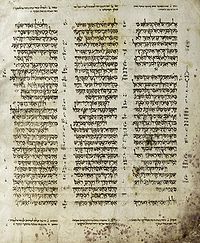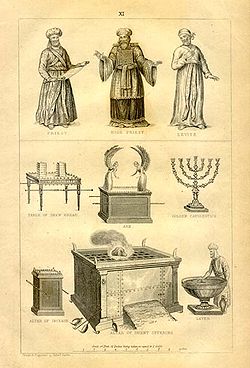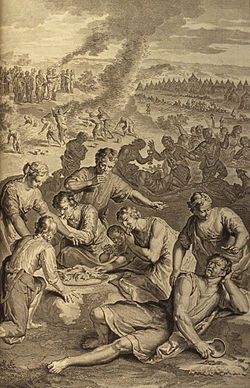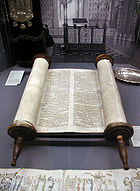- Book of Numbers
-
The Book of Numbers (from Greek Αριθμοί, Arithmoi; Hebrew: במדבר, Bəmidbar, "In the desert [of]") is the fourth book of the Hebrew Bible, and the fourth of five books of the Jewish Torah/Pentateuch.[1]
Numbers begins at Mount Sinai, where the Israelites have received their laws and covenant from God and God has taken up residence among them in the sanctuary.[2] The task before them is to take possession of the Promised Land. The people are numbered and preparations are made for resuming their march. The Israelites begin the journey, but immediately they "murmur" (complain or kvetch) at the hardships along the way. They arrive at the borders of Canaan and send spies into the land, but on hearing the spies' report the Israelites refuse to take possession of Canaan and God condemns them to death in the wilderness until a new generation can grow up and carry out the task. The book ends with the new generation of Israelites in the plain of Moab ready for the crossing of the Jordan River.[3]
Numbers is the culmination of the story of Israel's exodus from oppression in Egypt and their journey to take possession of the land God promised their fathers. As such it draws to a conclusion the themes introduced in Genesis and played out in Exodus and Leviticus: God has promised the Israelites that they shall become a great (i.e. numerous) nation, that they will have a special relationship with Yahweh their god, and that they shall take possession of the land of Canaan. Against this, Numbers also demonstrates the importance of holiness, faithfulness and trust: despite God's presence and his priests, Israel lacks faith and the possession of the land is left to a new generation.
The book has a long and complex history, but its final form is probably due to a Priestly redaction (i.e., editing) of a Yahwiistic original text some time in the early Persian period (5th century BCE).
Contents
Contents
Structure
Most commentators structure Numbers in three sections based on locale (Mount Sinai, Kadesh-Barnea and the plains of Moab), linked by two travel sections.[4] This view has the advantage of anchoring Numbers to the Pentateuch as a whole,[4] but an alternative is to see it as structured around the two generations of those condemned to die in the wilderness and the new generation who will enter Canaan, making a theological distinction being the disobedience of the first generation and the obedience of the second.[5]
Summary
God orders Moses, in the wilderness of Sinai, to number those able to bear arms—of all the men "from twenty years old and upward," and to appoint princes over each tribe. 603,550 Israelites are found to be fit for military service. In chapter 26, a generation later and after approximately forty years of wandering the desert, the Lord orders a second census. 601,730 men are counted.
The tribe of Levi is exempted from military service and therefore not included in the census totals. Moses consecrates the Levites for the service of the Tabernacle in the place of the first-born sons, who hitherto had performed that service. The Levites are divided into three families, the Gershonites, the Kohathites, and the Merarites, each under a chief, and all headed by one prince, Eleazar, son of Aaron. Preparations are then made for resuming the march to the Promised Land. Various ordinances and laws are decreed.
The first journey of the Israelites after the Tabernacle had been constructed is commenced. The people murmur against God and are punished by fire; Moses complains of the stubbornness of the Israelites and is ordered to choose seventy elders to assist him in the government of the people. Miriam and Aaron insult Moses at Hazeroth, which angers God; Miriam is punished with leprosy and is shut out of camp for seven days, at the end of which the Israelites proceed to the desert of Paran. Twelve spies are sent out into Canaan and come back to report to Moses. Joshua and Caleb, two of the spies, tell that the land is abundant and is "flowing with milk and honey"; the other spies say that it is inhabited by giants, and the Israelites refuse to enter the land. Yahweh decrees that the Israelites will be punished for their loss of faith by having to wander in the wilderness for 40 years.
Moses is ordered to make plates to cover the altar with the two hundred fifty censers left after the destruction of Korah's band. The children of Israel murmur against Moses and Aaron on account of the death of Korah's men and are stricken with the plague, with 14,700 perishing.
Aaron and his family are declared by God to be responsible for any iniquity committed in connection with the sanctuary. The Levites are again appointed to help in the keeping of the Tabernacle. The Levites are ordered to surrender to the priests a part of the tithes taken to them.
Miriam dies at Kadesh Barnea and the Israelites set out for Moab, on Canaan's western border. The Israelites blame Moses for the lack of water. Moses is ordered by God to speak to a rock but disobeys, and is punished by the announcement that he shall not enter Canaan. The king of Edom refuses permission to the Israelites to pass through his land and they go round it. Aaron dies on Mount Hor. The Israelites are bitten by Fiery flying serpents for speaking against God and Moses. A brazen serpent is made to ward off these serpents.
The Israelites arrive on the plains of Moab. A new census gives the total number of males from twenty years and upward as 601,730, and the number of the Levites from a month old and upward as 23,000. The land shall be divided by lot. The daughters of Zelophehad, their father having no sons, are to share in the allotment. Moses is ordered to appoint Joshua as his successor. Prescriptions for the observance of the feasts, and the offerings for different occasions are enumerated.
Moses orders the Israelites to massacre the people of Midian. The Reubenites and the Gadites request Moses to assign them the land east of the Jordan. Moses grants their request after they promise to help in the conquest of the land west of the Jordan. The land east of the Jordan is divided among the tribes of Reuben, Gad, and the half-tribe of Manasseh.
Moses recalls the stations at which the Israelites halted during their forty years' wanderings and instructs the Israelites to exterminate the Canaanites and destroy their idols. The boundaries of the land are spelled out; the land is to be divided under the supervision of Eleazar, Joshua, and twelve princes, one of each tribe.
Composition
Historical background
The key event in the formation of the Old Testament was the fall of the kingdom of Judah to the Babylonian empire in 586 BCE.[6] The Babylonians destroyed the city and the Temple of Solomon, executed the king's sons in front of him before putting out his eyes, and took him and many others into exile.[7] These events represented a major religious crisis: why had their god allowed this to happen? What had happened to the promise that the descendants of David would reign forever?[7] The answers were recorded in the works of the prophets Ezekiel, Jeremiah and Second Isaiah, and in the Deuteronomistic history, the collection of historical works from Joshua to Kings: God had not abandoned Israel; Israel had abandoned God, and the Babylonian exile was God's punishment for Israel's lack of faith.[8]
The Babylonian exile lasted approximately 48 years, from 586 to 538 BCE, and ended with the conquest of Babylon in that year by the Persians. The new Persian ruler decided to allow the exiles to return home. According to the book of Ezra-Nehemiah they did so under the joint leadership of a descendant of the last king and the last High Priest, rebuilding the Temple and reconstituting Judah (now called Yehud) as a holy community ruled by priests. It was in this period that the Pentateuch (or Torah, to give the Hebrew name) was composed, by detaching the book of Deuteronomy from the Deuteronomistic history and adding it to the books of Genesis, Exodus, Leviticus and Numbers.[9]
The Pentateuch (or Torah)
Ascribed by tradition to Moses, the Pentateuch had no single author, and its composition took place over centuries.[10] Its oldest layer, called the Yahwist, may date from the time of Solomon,[11] although many scholars now believe that it should be dated considerably later. It was given its current form by a group of authors and editors who lived in the Persian period, called the Priestly source, and Numbers therefore reflects the program of this group.[12] The text of Genesis-Numbers leaves no doubt as to the central concern of the priests: the cult of Yahweh was to be under the control of "Aaron and his sons" forever, and to the exclusion of all other priestly lines (such as Korah, Dathan and Abiram, who meet terrible fates in Numbers 16-17 for challenging Aaron, but also the lines of David's priests Abiathar and Zadok, as well as the low-level Levites).[12]
Themes
 Balaam and the Angel (illustration from the 1493 Nuremberg Chronicle)
Balaam and the Angel (illustration from the 1493 Nuremberg Chronicle)
David A. Clines, in his influential The Themes of the Pentateuch (1978), identified the overarching theme of the five books as the partial fulfilment of a promise to made by God to the patriarchs, to Abraham, Isaac and Jacob. The promise has three elements: posterity (i.e., descendants - Abraham is told that his descendants will be as innumerable as the stars), divine-human relationship (Israel is to be God's chosen people), and land (the land of Canaan, cursed by Noah immediately after the Deluge).[13]
The theme of the divine-human relationship is expressed, or managed, through a series of covenants (meaning treaties, legally binding agreements) stretching from Genesis to Deuteronomy and beyond. The first is the covenant between God and Noah immediately after the Deluge in which God agrees never again to destroy the Earth. The next is between God and Abraham, and the third between God and all Israel at Mount Sinai. In this third covenant, unlike the first two, God hands down an elaborate set of laws (scattered through Exodus, Leviticus and Numbers), which the Israelites are to observe; they are also to remain faithful to Yahweh, the god of Israel, meaning, among other things, that they must put their trust in his help.[14]
The theme of descendants marks the first event in Numbers, the census of Israel's fighting men: the huge number which results (over 600,000) demonstrates the fulfillment of God's promise to Abraham of innumerable descendants, as well as serving as God's guarantee of victory in Canaan.[15] As chapters 1-10 progress the theme of God's presence with Israel comes to the fore: these chapters describe how Israel is to be organised around the Sanctuary, God's dwelling-place in their midst, under the charge of the Levites and priests, in preparation for the conquest of the land.[16]
The Israelites then set out to conquer the land, but almost immediately they refuse to enter it and Yahweh condemns the whole generation who left Egypt to die in the wilderness. The message is clear: failure was not due to any fault in the preparation, because Yahweh had foreseen everything, but to Israel's sin of unfaithfulness. In the final section the Israelites of the new generation follow Yahweh's instructions as given through Moses and are successful in all they attempt.[16] The last five chapters are exclusively concerned with land: instructions for the extermination of the Canaanites, the demarcation of the boundaries of the land, how the land is to be divided, holy cities for the Levites and "cities of refuge", the problem of pollution of the land by blood, and regulations for inheritance when a male heir is lacking.[17]
Weekly Torah portions
In modern Judaism the Torah is divided into weekly Torah portions, so that the Torah is read publicly over the course of a year in the Shabbat morning service. The "portions" from Numbers are:
- *Bamidbar, on Numbers 1-4: First census, priestly duties
- *Naso, on Numbers 4-7: Priestly duties, the camp, unfaithfulness and the Nazirite, Tabernacle consecration
- *Behaalotecha, on Numbers 8-12: Levites, journing by cloud and fire, complaints, questioning of Moses
- *Shlach, on Numbers 13-15: Mixed report of the scouts and Israel's response
- *Korach, on Numbers 16-18: Korah’s rebellion, plague, Aaron’s staff buds, duties of the Levites
- *Chukat, on Numbers 19-21: Red heifer, water from a rock, Miriam’s and Aaron’s deaths, victories, serpents
- *Balak, on Numbers 22-25: Balaam's donkey and blessing
- *Pinchas, on Numbers 25-29: Phinehas, second census, inheritance, Moses' successor, offerings and holidays
- *Matot, on Numbers 30-34: Vows, Midian, dividing booty, land for Reuben, Gad, and half of Manasseh
- *Masei, on Numbers 33-36: Stations of the Israelites’ journeys, instructions for conquest, cities for Levites
See also
Books of the Torah - Genesis
- Exodus
- Leviticus
- Numbers
- Deuteronomy
- Balaam
- Book of the Wars of the Lord
- Inverted nun (only appears twice in the Book of Numbers and seven times in the Book of Psalms)
- Priestly Blessing
- Torah
- Weekly Torah portions in Numbers: Bamidbar, Naso, Behaalotecha, Shlach, Korach, Chukat, Balak, Pinchas, Matot, and Masei
- What hath God wrought
- Wilderness of Sin
References
Bibliography
Part of a series on The Hebrew Bible
and DeuterocanonGenesis · Exodus · Leviticus · Numbers
Deuteronomy · Joshua · Judges · Ruth
1–2 Samuel · 1–2 Kings · 1–2 Chronicles
Ezra · Nehemiah · Esther · Job · Psalms
Proverbs · Ecclesiastes · Song of Songs
Isaiah · Jeremiah · Lamentations
Ezekiel · Daniel · Minor prophetsTobit · Judith · 1–2 Maccabees
Wisdom (of Solomon) · Sirach
Baruch · Letter of Jeremiah
Additions to Daniel / to Esther Bible portal
Bible portalTranslations of Numbers
Commentaries on Numbers
- Ashley, Timothy R (1993). The Book of Numbers. Eerdmans. http://books.google.com.au/books?id=6hBSceHiuAAC&printsec=frontcover&dq=book+of+numbers#v=onepage&q&f=false.
- Fretheim, Terence E (1998). "Numbers". In John Barton. Oxford Bible Commentary. Oxford University Press. http://books.google.com.au/books?id=3surkLVdw3UC&pg=PA110&dq=The+Oxford+Bible+commentary+Numbers+Fretheim#v=onepage&q=The%20Oxford%20Bible%20commentary%20Numbers%20Fretheim&f=false.
- Knierim, Rolf P; Coats, George W (2005). Numbers. Eerdmans. http://books.google.com/books?id=3knG1LJEiTsC&printsec=frontcover&dq=Knierim+Numbers#v=onepage&q&f=false.
- Olson, Dennis T (1996). Numbers. Westminster John Knox Press. http://books.google.com.au/books?id=Rus0KUTNUg4C&printsec=frontcover&dq=Numbers+Dennis+T.+Olson#v=onepage&q&f=false.
- Stubbs, David L (2009). Numbers. Brazos Press. http://books.google.com.au/books?id=Rus0KUTNUg4C&printsec=frontcover&dq=Numbers+Dennis+T.+Olson#v=onepage&q&f=false.
General
- Bandstra, Barry L (2004). Reading the Old Testament: an introduction to the Hebrew Bible. Wadsworth. http://books.google.com.au/books?id=vRY9mTUZKJcC&pg=PA489&lpg=PA489&dq=Bandstra,+Barry+L+%282004%29.+Reading+the+Old+Testament:+an+introduction+to+the+Hebrew+Bible#v=onepage&q&f=false.
- Blenkinsopp, Joseph (2004). Treasures old and new: essays in the theology of the Pentateuch. Eerdmans. http://books.google.com.au/books?id=wq0YsOpTjKIC&printsec=frontcover&dq=Treasures+old+and+new:+essays+in+the+theology+of+the+Pentateuch#v=onepage&q&f=false.
- Brueggemann, Walter (2002). Reverberations of faith: a theological handbook of Old Testament themes. Westminster John Knox. http://books.google.com.au/books?id=dBJQ71RIpdMC&printsec=frontcover&dq=theological+handbook+of+Old+Testament+themes#v=onepage&q&f=false.
- Campbell, Antony F; O'Brien, Mark A (1993). Sources of the Pentateuch: texts, introductions, annotations. Fortress Press. http://books.google.com.au/books?id=cwhICpcHBsQC&pg=PR3&dq=Sources+of+the+bible&cad=3#v=onepage&q=Sources%20of%20the%20bible&f=false.
- Clines, David A (1997). The theme of the Pentateuch. Sheffield Academic Press. http://books.google.com.au/books?id=Z45ullcFRG8C&printsec=frontcover&dq=Clines+Theme+of+the+Pentateuch#v=onepage&q&f=false.
- Dawes, Gregory W (2005). Introduction to the Bible. Liturgical Press. http://books.google.com.au/books?id=UX9RsDHKp7wC&printsec=frontcover&dq=Introduction+to+the+Bible+Gregory+W.+Dawes#v=onepage&q&f=false.
- Gilbert, Christopher (2009). A Complete Introduction to the Bible. Paulist Press. http://books.google.com.au/books?id=q9XUv3KAVIUC&printsec=frontcover&dq=A+Complete+Introduction+to+the+Bible+Christopher+Gilbert#v=onepage&q&f=false.
- Knierim, Rolf P (1995). The task of Old Testament theology: substance, method, and cases. Eerdmans. http://books.google.com/books?id=nE-xfAGv3ScC&pg=PA381&dq=Knierim+Numbers#v=onepage&q&f=false.
- Kugler, Robert; Hartin, Patrick (2009). An Introduction to the Bible. Eerdmans. http://books.google.com.au/books?id=L8WbXbPjxpoC&printsec=frontcover&dq=Robert+Kugler,+Patrick+Hartin#v=onepage&q&f=false.
- McDermott, John J (2002). Reading the Pentateuch: a historical introduction. Pauline Press. http://books.google.com.au/books?id=Dkr7rVd3hAQC&printsec=frontcover&dq=Reading+the+Pentateuch:+a+historical+introduction#v=onepage&q&f=false.
- Van Seters, John (2004). The Pentateuch: a social-science commentary. Continuum International Publishing Group. http://books.google.com.au/books?id=T-Vi9eK_vS0C&pg=PA7&dq=Sources+of+the+bible&cad=3#v=onepage&q=Sources%20of%20the%20bible&f=false.
- Van Seters, John (1998). "The Pentateuch". In Steven L. McKenzie, Matt Patrick Graham. The Hebrew Bible today: an introduction to critical issues. Westminster John Knox Press. http://books.google.com.au/books?id=owwhpmIVgSAC&printsec=frontcover&dq=The+Hebrew+Bible+today:+an+introduction+to+critical+issues#v=onepage&q&f=false.
- Ska, Jean-Louis (2006). Introduction to reading the Pentateuch. Eisenbrauns. http://books.google.com.au/books?id=7cdy67ZvzdkC&printsec=frontcover&dq=Introduction+to+reading+the+Pentateuch+Jean+Louis+Ska#v=onepage&q&f=false.
External links
- Original language:
- במדבר Bamidbar - Numbers (Hebrew – English at Mechon-Mamre.org)
- Jewish translations:
- Numbers at Mechon-Mamre (Jewish Publication Society translation)
- Numbers (The Living Torah) Rabbi Aryeh Kaplan's translation and commentary at Ort.org
- Bamidbar - Numbers (Judaica Press) translation [with Rashi's commentary] at Chabad.org
- Christian translations:
Book of NumbersPreceded by
LeviticusHebrew Bible Succeeded by
DeuteronomyChristian
Old TestamentBooks of the Bible Principal divisions Orthodox- Enoch
- Jubilees
- 1-3 Meqabyan
- Paralipomena of Baruch
Subdivisions Development Manuscripts See also Categories:- Book of Numbers
- Torah books
Wikimedia Foundation. 2010.




